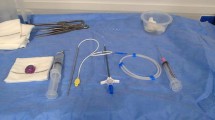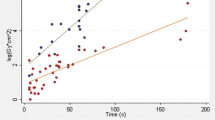Abstract
Purpose. We report our experience in the safe use of power injectors with central and small-gauge peripheral venous access devices for intravenous administration of contrast agent to children undergoing computed tomography (CT) examinations.Materials and methods. We reviewed the medical records of 500 patients randomly selected from the 3121 children who underwent intravenous contrast-enhanced CT examinations at our institution from November 1993 through July 1995.Results. The group of 500 patients, all younger than 18 years of age, accounts for 16 % of the contrast-enhanced CT examinations performed during the study period. Medrad MCT 311 Mark V or Medrad MCT Plus 311 power injectors were used to intravenously administer Omnipaque 300 (2 ml/kg, maximum dose = 150 ml) through venous access devices. These devices comprised Hickman or Broviac lines (n = 228), subcutaneous Port-A-Caths (n = 55), small-gauge butterfly needles (n = 215), and percutaneous intravenous central lines (n = 2). Two complications, one involving a Hickman line and the other a subcutaneous Port-A-Cath, occurred in the study population. These complications correspond to a frequency of 0.4 %. Six cases of contrast extravasation, all of them with the use of 23- (n = 1) and 25-gauge (n = 5) butterfly catheters (frequency = 0.2 %), occurred among the remaining 2621 cases.Conclusion. In light of the low frequency of complications, power injectors and central venous access devices or small-gauge butterfly catheters are safe systems for delivery of intravenous contrast material to pediatric patients. We feel that our strict adherence to manufacturers' guidelines and previously reported techniques partially accounts for our success with these modes of delivery.
Similar content being viewed by others
References
Medrad (1989) MCT/MCT Plus Injector with front load syringe. Operation manual. Medrad, Pittsburgh, Pa
Goss J, Ramo BW, Raff GO, et al (1989) Power injection of contrast medium during percutaneous transluminal coronary angioplasty. Cathet Cardiovasc Diagn 16: 195–198
Shuman WP, Adam JL, Schoenecker SA, Taziolo PR, Moss AA (1986) Use of a power injector during dynamic computed tomography. J Comput Assist Tomogr 10: 1000–1002
Tada S, Fukuda K, Aoyagi Y, Harada J (1980) CT of abdominal malignancies: dynamic approach. AJR 135: 455–461
Shepard JOA, Dedrick CG, Spizarny DL, McLoud TC (1986) Dynamic incremental computed tomography of the pulmonary hila using a flow-rate injector. J Comput Assist Tomogr 10: 369–371
McCarthy S, Moss AA (1984) The use of a flow rate injector for contrast-enhanced computed tomography. Radiology 151: 800
Burgener FA, Hamlin DJ (1983) Contrast enhancement of hepatic tumors in CT: comparison between bolus and infusion techniques. AJR 140: 291–295
Carlson JE, Hellen LJ, Trenkner SW, Ritenour R, Halvorsen RA (1992) Safety consideration in the power injection of contrast medium via central venous catheters during competed tomographic examinations. Invest Radiol 27: 337–340
Author information
Authors and Affiliations
Rights and permissions
About this article
Cite this article
Kaste, S.C., Young, C.W. Safe use of power injectors with central and peripheral venous access devices for pediatric CT. Pediatr Radiol 26, 499–501 (1996). https://doi.org/10.1007/BF01372228
Received:
Accepted:
Issue Date:
DOI: https://doi.org/10.1007/BF01372228




